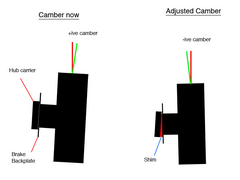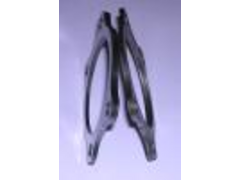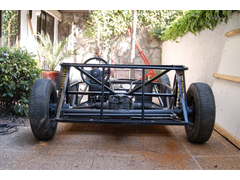
rear axle shims
robertst - 18/2/08 at 11:39 PM
the rear wheels on my locost currently have a big positive camber. having a de-dion axle, i guess the only way to fix this is to use shims.. but
where? surely shims used between the wheel and the hub would make the wheel vibrate?
i drew this to illustrate my current problem... a possible solution might be to use a shim between the hub carrier and the brake backplate, but i
realized that the bolts would not fit squarely, requiring machining on both the hub and the hub carrier...
what can i do to solve this? any ideas? sorry fot the crude drawing: i'm on a laptop thanks in advance
thanks in advance
Tom


Rescued attachment rear_shim.jpg
Minicooper - 18/2/08 at 11:53 PM
Hello Tom,
Shiming is fine, I'm done something simliar with my de dion, on mine though I can shim the hub carrier as the brake disk,etc is mounted on the
hub carrier.
I just thought I would add, I've only needed to shim a very small amount to get the desired effect, I made a jig and tried to get it as close as
possible to what I wanted.
In your case will you not need to shim behind the drum back-plate to keep the hub carrier, drum brake relationship correct other than that it should
be fine
Cheers
David
[Edited on 19/2/08 by Minicooper]
robertst - 19/2/08 at 02:49 AM
cheers david,
i'm still confused though... by shimming do you mean grinding away the hub carrier to compensate? or making a profiled plate to fit between the
hub carrier and the hub?
snapper - 19/2/08 at 08:33 AM
Camber wedges, can be cut in half to aid fitting and are a simple copy of the hub carrier them milled at the required angle, the Robin Hood guys have
been making them and fitting them for years.


Rescued attachment Camber wedges.jpg
snapper - 19/2/08 at 08:38 AM
A point to remember is that the bolt pattern of the disc brake set up is the same as the drum brake but rotated 90 degrees so you need to state which
you have also the angle is build specific and you can have it milled in two planes to set rear toe as well as camber.
Camber wedge thread
snapper - 19/2/08 at 08:50 AM
quote:
In your case will you not need to shim behind the drum back-plate to keep the hub carrier, drum brake relationship correct other than that it should
be fine
Yes you do.
You can do the initial setup with washers to find the difference needed between top thickness and bottom on the camber wedge.
procomp - 19/2/08 at 09:04 AM
Hi is it simply not easier to tweek the dedion beam it's self as done on the caterhams. And live axles in general.
Cheers Matt
Mr Whippy - 19/2/08 at 09:06 AM
How amusing, I tried fitting sierra rear suspension to my Falcon but gave up due to the camber I was getting. Never even considered shims...tisk
britishtrident - 19/2/08 at 11:35 AM
if the de Dion tube is steel run a bead of weld o the top of tube at the centre then quench cool --- this will contract the top of the tube, give
nore negative camber..
NS Dev - 19/2/08 at 01:30 PM
Caterhams run alloy blocks to mount the rear hubs each end of the de-dion axle.
They are pre-machined with a certain castor and its not at all unheard of (not that we would do anything that is against any regulations of course!!
 ) to machine them to alternative angles!!
) to machine them to alternative angles!!
The weld and shrink won't move em very far at all.
Shims are your best bet after using a press to get it somewhere near to start with.
Hacksaw blade stock makes excellent shim for the job.
NS Dev - 19/2/08 at 01:32 PM
ps wedge or block goes between hub carrier and its mounting on the beam, and no, the bolts won't be square, but for the amount they will be out
it doesn't matter.
Minicooper - 19/2/08 at 01:50 PM
quote:
Originally posted by robertst
cheers david,
i'm still confused though... by shimming do you mean grinding away the hub carrier to compensate? or making a profiled plate to fit between the
hub carrier and the hub?
Tom,
I spent ages getting the jig accurate and with careful welding I was able to get the axle so close I only needed the thinest of shims, sounds like you
need more substantial intervention
I would in your case get the basic shape right using the bead of weld method or a heat scource to get it all basically pointing in mostly the right
direction and then use the thin shims for final adjustment
How much is it out? a 1 mm shim will move the outer edge of the wheel about 3 or 4mm would that be enough or is it loads out?
Tom just had a look at this picture in your archive, the rears look close enough to be shimed to me
http://www.locostbuilders.co.uk/photos.php?action=showphoto&photo=rolling_chas.jpg
Cheers
David
[Edited on 19/2/08 by Minicooper]
robertst - 19/2/08 at 05:01 PM
here's a better pic, the left wheel has a larger camber than the right one, but i guess if the ratio is 3:1, then i wont need such a thick
wedge.
the washer idea is a good one... i'll do that to measure how much i need.
final q: where can i get these wedges or do i have to make them myself?
thanks a lot for your help, i thought i wouldn't be able to get the camber fixed up.


Rescued attachment DSC_0179.jpg
NS Dev - 19/2/08 at 06:57 PM
they are a make it yourself job, basically use washers or measure accurately to work out the angle required in both planes. Then over the hub carrier
height/width work out the thickest bit of wedge required (if you see what i mean) assuming a small thickness at the thinnest point.
Then get some steel or alloy plate of that thickness, set it up at the required angle in a millign machine and mill it down until the
"thick" and "thin" sides are the required thicknesses, which should happen simultanously if you got the angle right!!
This is how I have done some which of course weren't for use on a caterham racing car.
Alternatively, drill strips of steel shim stock to the bolt centres of the hub carrier in the appropriate place, and sandwich in there before bolting
up.
The first method is much better, the second much easier!
I'd tweak the whole axle in a friendly garage's hydraulic press first though to get the "least wrong" wheel correct, then shim the
other one.
robertst - 19/2/08 at 07:06 PM
got it... great help, thanks a lot
 thanks in advance
thanks in advance 




 ) to machine them to alternative angles!!
) to machine them to alternative angles!! 
